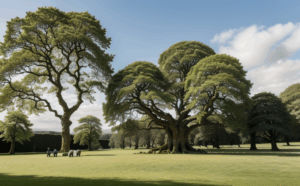A cherished natural landmark, the venerable sycamore tree on the historic grounds of Scone Palace, believed to have stood for over 400 years since the 17th century, has suffered extensive harm following the recent onslaught of Storm Amy. This majestic arboreal sentinel, intimately linked with the era of King James VI, endured the full force of the tempest, resulting in a significant portion of its ancient canopy being torn away by the ferocious winds.
The storm, which unleashed its formidable power across Tayside and parts of Perth and Kinross on Friday and Saturday, brought with it wind gusts recorded at up to an astonishing 100mph over the Tay Road Bridge during its peak intensity. The widespread disruption and damage left in its wake were felt keenly across the region, making the news of the sycamore’s plight particularly poignant for local residents and history enthusiasts alike. Dedicated Efforts to Preserve a Living Legacy
In the aftermath of the storm’s fury, the dedicated team at Scone Palace, including their expert gardeners and professional tree surgeons, immediately embarked on a concerted effort to mitigate the damage and salvage what remains of this irreplaceable tree. Their commitment underscores the profound historical and sentimental value the sycamore holds within the Scottish landscape.
A statement from Scone Palace expressed the profound sadness felt by all involved:
“In the aftermath of Storm Amy, we were heartbroken to discover that the historic King James VI Sycamore has suffered severe damage. Our dedicated gardening team and tree surgeons are doing everything possible to preserve what remains of this historic tree. We also hope to honour its legacy by using wood from the fallen limb to create something that will be a lasting reminder of its centuries of growth and resilience.”
This initiative not only aims to ensure the continued life of the sycamore but also seeks to transform the unfortunate event into an opportunity to perpetuate its memory through tangible creations from the fallen wood, allowing its story to endure for generations. A Royal Witness Through the Ages
The King James VI sycamore, a prominent feature overlooking the sprawling acres of Scone Palace, is more than just a tree; it is a living chronicle of Scottish royalty and heritage. Its roots delve back to a period when Scotland was at a pivotal point in its history, providing a tangible connection to King James VI, who later ascended to the English throne as King James I.
As described on Scone Palace’s official website, the tree embodies the spirit of an era:
“The sycamore tree, with its sprawling branches and lush foliage, serves as a living symbol of King James VI’s reign and the prosperity of Scotland during his time. Its towering presence commands attention, casting a majestic silhouette against the backdrop of Scone Palace’s historic grounds. Throughout the centuries, the King James VI Sycamore has borne witness to countless royal ceremonies, celebrations, and gatherings. Its sturdy trunk and verdant canopy have provided shade and shelter to generations of visitors, offering a peaceful respite amid the splendour of the palace gardens. The significance of the King James VI Sycamore extends beyond its historical roots. For many, it serves as a tangible link to Scotland’s rich heritage and royal traditions, evoking a sense of pride and reverence for the nation’s storied past.”
Indeed, this ancient sycamore has silently observed countless significant moments, from royal coronations and state visits to the everyday lives of those who have walked these hallowed grounds. Its enduring presence has offered shade and sanctuary, contributing to the serene grandeur that defines Scone Palace.
For the community of Perth and Kinross, the sycamore represents a profound connection to their local history, a silent guardian that links the present to a distant past. Its resilience in the face of natural forces mirrors the enduring spirit of the region itself.
Scone Palace is also home to other remarkable trees, including the revered Coronation Cedar, planted in 1838 to commemorate the coronation of Queen Victoria. These living monuments collectively contribute to the unique natural and historical tapestry of this celebrated Perthshire estate, inviting visitors and locals alike to reflect on the passage of time and the deep roots of Scotland’s heritage. The Broader Impact on Perthshire’s Natural Heritage
While the immediate focus is on the sycamore at Scone Palace, the broader impact of Storm Amy on Perthshire’s diverse natural landscapes cannot be underestimated. The region, known for its stunning woodlands, river systems, and rolling hills, undoubtedly saw many other trees and natural features affected by the storm’s ferocity. Local conservation groups and estate managers across Perth and Kinross will be assessing the full extent of the damage in the coming weeks, working to restore and protect the precious environmental assets that define the area. The collective effort at Scone Palace serves as a powerful reminder of the dedication required to safeguard these living links to our past and ensure they continue to inspire future generations in Perthshire and beyond.
The storm, which unleashed its formidable power across Tayside and parts of Perth and Kinross on Friday and Saturday, brought with it wind gusts recorded at up to an astonishing 100mph over the Tay Road Bridge during its peak intensity. The widespread disruption and damage left in its wake were felt keenly across the region, making the news of the sycamore’s plight particularly poignant for local residents and history enthusiasts alike. Dedicated Efforts to Preserve a Living Legacy
In the aftermath of the storm’s fury, the dedicated team at Scone Palace, including their expert gardeners and professional tree surgeons, immediately embarked on a concerted effort to mitigate the damage and salvage what remains of this irreplaceable tree. Their commitment underscores the profound historical and sentimental value the sycamore holds within the Scottish landscape.
A statement from Scone Palace expressed the profound sadness felt by all involved:
“In the aftermath of Storm Amy, we were heartbroken to discover that the historic King James VI Sycamore has suffered severe damage. Our dedicated gardening team and tree surgeons are doing everything possible to preserve what remains of this historic tree. We also hope to honour its legacy by using wood from the fallen limb to create something that will be a lasting reminder of its centuries of growth and resilience.”
This initiative not only aims to ensure the continued life of the sycamore but also seeks to transform the unfortunate event into an opportunity to perpetuate its memory through tangible creations from the fallen wood, allowing its story to endure for generations. A Royal Witness Through the Ages
The King James VI sycamore, a prominent feature overlooking the sprawling acres of Scone Palace, is more than just a tree; it is a living chronicle of Scottish royalty and heritage. Its roots delve back to a period when Scotland was at a pivotal point in its history, providing a tangible connection to King James VI, who later ascended to the English throne as King James I.
As described on Scone Palace’s official website, the tree embodies the spirit of an era:
“The sycamore tree, with its sprawling branches and lush foliage, serves as a living symbol of King James VI’s reign and the prosperity of Scotland during his time. Its towering presence commands attention, casting a majestic silhouette against the backdrop of Scone Palace’s historic grounds. Throughout the centuries, the King James VI Sycamore has borne witness to countless royal ceremonies, celebrations, and gatherings. Its sturdy trunk and verdant canopy have provided shade and shelter to generations of visitors, offering a peaceful respite amid the splendour of the palace gardens. The significance of the King James VI Sycamore extends beyond its historical roots. For many, it serves as a tangible link to Scotland’s rich heritage and royal traditions, evoking a sense of pride and reverence for the nation’s storied past.”
Indeed, this ancient sycamore has silently observed countless significant moments, from royal coronations and state visits to the everyday lives of those who have walked these hallowed grounds. Its enduring presence has offered shade and sanctuary, contributing to the serene grandeur that defines Scone Palace.
For the community of Perth and Kinross, the sycamore represents a profound connection to their local history, a silent guardian that links the present to a distant past. Its resilience in the face of natural forces mirrors the enduring spirit of the region itself.
Scone Palace is also home to other remarkable trees, including the revered Coronation Cedar, planted in 1838 to commemorate the coronation of Queen Victoria. These living monuments collectively contribute to the unique natural and historical tapestry of this celebrated Perthshire estate, inviting visitors and locals alike to reflect on the passage of time and the deep roots of Scotland’s heritage. The Broader Impact on Perthshire’s Natural Heritage
While the immediate focus is on the sycamore at Scone Palace, the broader impact of Storm Amy on Perthshire’s diverse natural landscapes cannot be underestimated. The region, known for its stunning woodlands, river systems, and rolling hills, undoubtedly saw many other trees and natural features affected by the storm’s ferocity. Local conservation groups and estate managers across Perth and Kinross will be assessing the full extent of the damage in the coming weeks, working to restore and protect the precious environmental assets that define the area. The collective effort at Scone Palace serves as a powerful reminder of the dedication required to safeguard these living links to our past and ensure they continue to inspire future generations in Perthshire and beyond.


